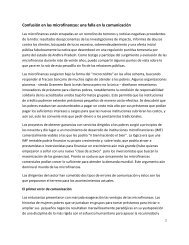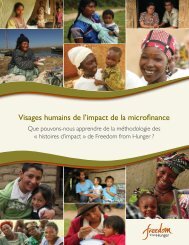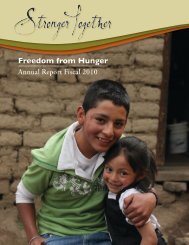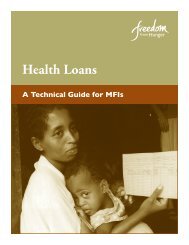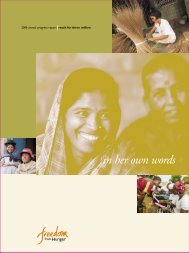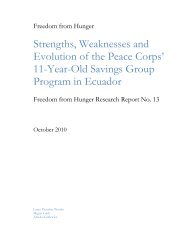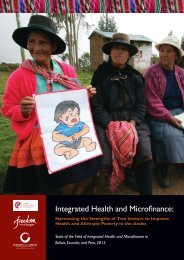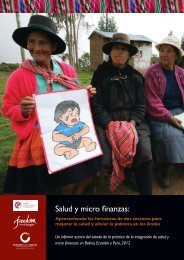history of meals for millions, soy, and freedom from ... - SoyInfo Center
history of meals for millions, soy, and freedom from ... - SoyInfo Center
history of meals for millions, soy, and freedom from ... - SoyInfo Center
You also want an ePaper? Increase the reach of your titles
YUMPU automatically turns print PDFs into web optimized ePapers that Google loves.
Caltech kitchen palatability became boss <strong>of</strong> the experiment.<br />
The result, late in 1944, was the ‘multi-purpose meal.’<br />
“Its tasty <strong>for</strong>mula is dominated by 68 percent <strong>of</strong><br />
<strong>soy</strong>bean grits, low in fat <strong>and</strong> high in protein. To this are<br />
added dehydrated potatoes, cabbage, tomatoes, onions,<br />
leeks, parsley <strong>and</strong> spices. It is <strong>for</strong>tified with calcium,<br />
concentrated Vitamins A <strong>and</strong> D, <strong>and</strong> the major B synthetic<br />
vitamins. It is a satisfying, sustaining food; it has eye<br />
appeal, bite appeal <strong>and</strong> taste appeal. I’ve eaten it, <strong>and</strong> can<br />
testify that it’s good.<br />
“The multi-purpose meal, or MPM, is simple to<br />
prepare. All that’s needed is a kettle, water <strong>and</strong> the fire to<br />
boil it <strong>for</strong> 30 minutes. Two-<strong>and</strong>-a-quarter ounces <strong>of</strong> MPM,<br />
dry weight, furnishes the major portion <strong>of</strong> a highly<br />
palatable, nutritious meal <strong>for</strong> one person. It becomes a<br />
casserole dish, a stew or a soup, depending upon whether<br />
you add five, eight or 14 ounces <strong>of</strong> water. One ounce <strong>of</strong> any<br />
kind <strong>of</strong> fat brings the caloric value <strong>of</strong> MPM up to one third<br />
<strong>of</strong> a day’s life-sustaining ration. If no fat is to be had, then<br />
two slices <strong>of</strong> bread make up the necessary calories...<br />
“The new meal is well within the economy <strong>of</strong> the<br />
liberated nations. For five cents per serving, MPM can give<br />
Europe’s hungry the nutritional equivalent <strong>of</strong> a meal<br />
consisting <strong>of</strong> one-quarter pound each <strong>of</strong> beef, peas <strong>and</strong><br />
potatoes, <strong>and</strong> one-half pint <strong>of</strong> milk. Because it is<br />
dehydrated, MPM is compact <strong>and</strong> easy to ship.<br />
“Of course the pro<strong>of</strong> <strong>of</strong> this life-saving pudding is in its<br />
eating, <strong>and</strong> it has come triumphantly through its field trials.<br />
It is being served regularly to 7,000 children in the<br />
Burbank, Cali<strong>for</strong>nia, schools <strong>and</strong> in more than 200 other<br />
schools in southern Cali<strong>for</strong>nia, with high acceptance by<br />
pupils <strong>and</strong> teachers. In varied entrée combinations, it is<br />
being served at a rate <strong>of</strong> 400 <strong>meals</strong> a day in Clinton’s Los<br />
Angeles cafeterias. MPM passed the exacting palatability<br />
tests <strong>of</strong> George Mardikian, famed owner-chef <strong>of</strong> the Omar<br />
Khayyam Restaurant in San Francisco, <strong>and</strong> under his<br />
supervision it was served regularly to the delegates at the<br />
United Nations Conference. No element in it violates the<br />
dietary customs <strong>and</strong> laws <strong>of</strong> any nation; <strong>and</strong> delegates <strong>from</strong><br />
all parts <strong>of</strong> the world spoke highly <strong>of</strong> its palatability.<br />
“Caltech’s scientists, Clif<strong>for</strong>d Clinton <strong>and</strong> the<br />
Cali<strong>for</strong>nia dehydrators who developed MPM have taken out<br />
no patents. Its <strong>for</strong>mula <strong>and</strong> know-how are free to anyone<br />
requesting it <strong>from</strong> the Cali<strong>for</strong>nia Institute <strong>of</strong> Technology,<br />
Pasadena, Calif.”<br />
Note 1. This is earliest document seen (Jan. 2011) that<br />
mentions “Meals <strong>for</strong> Millions” <strong>of</strong> Los Angeles, or that<br />
mentions their “multi-purpose meal.” It is also the earliest<br />
published document seen concerning Clif<strong>for</strong>d E. Clinton in<br />
connection with this organization (which he founded) or this<br />
food (which he conceived <strong>of</strong> <strong>and</strong> paid to have developed).<br />
Note 2. Victory in Europe Day was 8 May 1945. On<br />
that date the World War II Allies <strong>for</strong>mally accepted the<br />
MEALS FOR MILLIONS, SOY, AND FREEDOM FROM HUNGER 27<br />
© Copyright Soyinfo <strong>Center</strong> 2011<br />
unconditional surrender <strong>of</strong> the armed <strong>for</strong>ces <strong>of</strong> Nazi<br />
Germany <strong>and</strong> the end <strong>of</strong> Adolf Hitler’s Third Reich.<br />
31. Los Angeles Times.1945. Quiz ‘em. Oct. 21. p. E13.<br />
• Summary: 2. Hungry Europe: What is the multi-purpose<br />
food that we are making to alleviate hunger in Europe?<br />
Answer: It’s a dehydrated mixture. A pound <strong>of</strong> it will<br />
make 5 pounds <strong>of</strong> stew, or a 5-gallon can <strong>of</strong> it will make<br />
1,000 bowls <strong>of</strong> soup.–I.D.W., Taunton, Massachusetts.<br />
Note 1. This is the earliest document seen (<strong>and</strong> the<br />
earliest item seen in the Los Angeles Times) (Jan. 2011) that<br />
mentions “multi-purpose food.” It is not a real article but a<br />
very brief letter to the editor. The Times has not yet<br />
mentioned the “Meals <strong>for</strong> Millions Foundation” or Clif<strong>for</strong>d<br />
Clinton’s work with famine relief. One soon gets the strong<br />
impression that the Los Angeles Times was deliberately not<br />
covering Clinton’s work with Meals <strong>for</strong> Millions <strong>and</strong> multipurpose<br />
food.<br />
Be<strong>for</strong>e 1960 the Los Angeles Times had been part <strong>of</strong> the<br />
power structure in Los Angeles. Harry Ch<strong>and</strong>ler (Otis<br />
Ch<strong>and</strong>ler’s son; 2nd generation) ran the paper <strong>from</strong> 1917 to<br />
1944. He was ruthless <strong>and</strong> a real estate speculator. When<br />
Clif<strong>for</strong>d Clinton <strong>and</strong> the CIVIC committee (see Food <strong>for</strong><br />
Thot, March 12, 1970) worked to clean up waste <strong>and</strong><br />
corruption in Los Angeles <strong>from</strong> about 1936-1941, the Times<br />
strongly opposed their ef<strong>for</strong>ts <strong>and</strong> either gave their re<strong>for</strong>m<br />
work scant coverage or covered it with critical, one-sided<br />
articles.<br />
In 1944 Norman Ch<strong>and</strong>ler (Harry’s son <strong>and</strong> 3rd<br />
generation) took charge <strong>of</strong> the paper, <strong>and</strong> with his wife<br />
Dorothy Buffum, tried to make the paper more respectable,<br />
but their work was opposed by other branches <strong>of</strong> the<br />
powerful Ch<strong>and</strong>ler family.<br />
In 1960, Otis Ch<strong>and</strong>ler (4th generation) took charge <strong>of</strong><br />
the newspaper. He trans<strong>for</strong>med the Times <strong>from</strong> a journalistic<br />
outcast to one <strong>of</strong> the most respected papers in the USA, <strong>and</strong><br />
made excellent money at the same time. “Let’s Be the Best”<br />
was his motto, <strong>and</strong> he won 12-14 Pulitzer Prizes. The right<br />
wing faction <strong>of</strong> the Ch<strong>and</strong>ler family hated his new policy <strong>of</strong><br />
fair <strong>and</strong> balanced reporting, <strong>and</strong> manipulated behind the<br />
scenes.<br />
There<strong>for</strong>e any articles about Clif<strong>for</strong>d Clinton or his<br />
work published in the Los Angeles Times be<strong>for</strong>e 1960 must<br />
be viewed with caution <strong>and</strong> in light <strong>of</strong> the views <strong>of</strong> the<br />
newspaper. Source: “Inventing L.A.: The Ch<strong>and</strong>lers <strong>and</strong><br />
Their Times,” documentary on PBS-TV, Oct. 2009.<br />
Note 2. This short article also appeared in the Chicago<br />
Sun on this same date.<br />
32. Soybean Digest.1945. To feed world’s starving peoples:<br />
M.P.M. Five-cent <strong>soy</strong> meal. Dec. p. 14.<br />
• Summary: Based on an article by Paul de Kruif in<br />
Reader’s Digest, this one adds some details. “A food<br />
consisting <strong>of</strong> 68 percent <strong>soy</strong> grits combined with dehydrated



